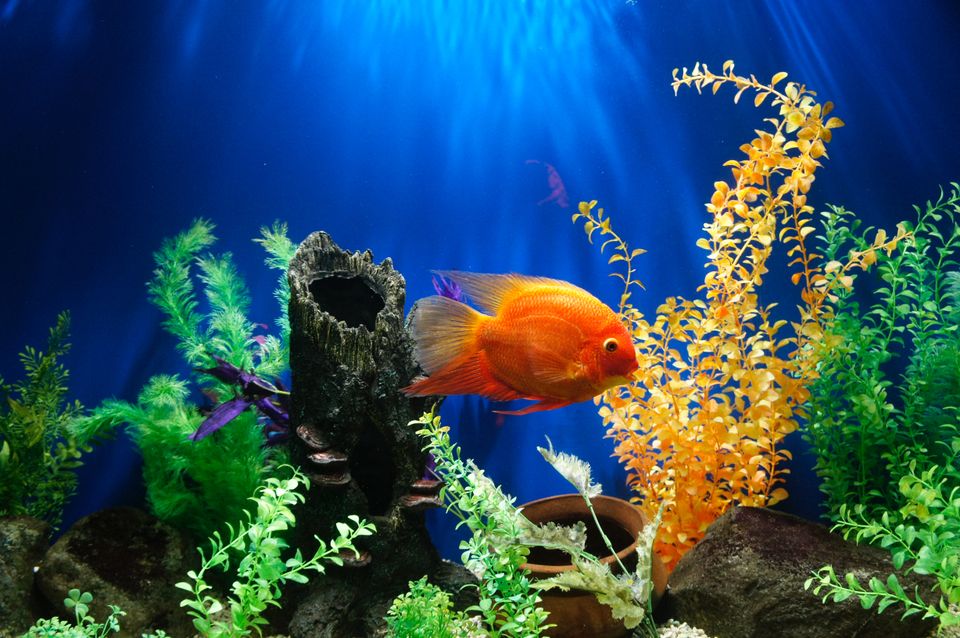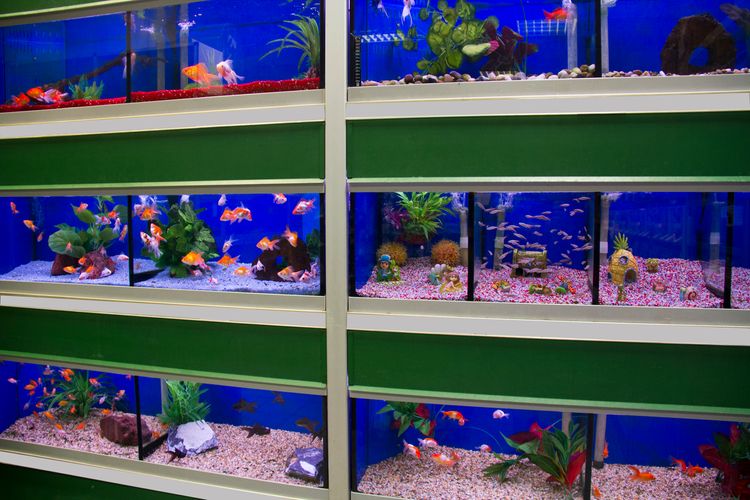FISH KEEPING 101: A Step-by-Step Guide to Set Up an Aquarium for Beginners

There is something enchanting about watching fish swim gracefully around an aquarium. Whether you're an aspiring aquarist or just looking to add some life to your living or working space, setting up an aquarium can be an enjoyable and rewarding experience. However, for those new to the world of fishkeeping, it can also seem like a daunting task. There is SO MUCH information available on the internet, and often it can be contradictory. After all, there are many different approaches and reasons for keeping fish. So where do you even begin?? In this post, we will guide you through the 7 basic steps to set up an aquarium for beginners, ensuring that you can be confident as you create a happy and healthy environment for your new aquatic pets!
STEP 1: Planning Your Aquarium
Before diving right into (see what I did there?) the world of fishkeeping, it's really important to take some time to plan out your aquarium. So make your best effort to push pause, avoid any impulse Amazon or Petco purchases, and think about the following factors:
- Location: The place where you want to put a fish tank might not be the same place as where you should put it. Is there a source of water nearby? How about a drain? How will you get water to (and from) your tank? Will spills be easy to clean up? Where are heating and cooling sources like vents and radiators located? Does the space get lots of direct sunlight from a window? For your first fish tank, it’s probably a good idea to choose a spot that minimizes temperature fluctuations and drafts or excessive natural light. This will help maintain a stable environment for your fish and reduce algae growth. Also ensure the spot you pick can support the weight of a filled aquarium. You really don’t want to risk damaging your home because the floor couldn’t structurally support your tank! Also consider why you want a fish tank. Is it because you want an awesome display to look at and relax in front of? Or do you want to experiment with breeding a certain species and raise their fry?
- Size: The size of your aquarium will determine the type and number of fish you can keep. Larger tanks tend to be more forgiving and stable, making them more suitable for beginners. A 20-30 gallon tank is a great starting point, especially if you have the perfect location to put it in. 10 gallon tanks are also suitable if you just don’t have the space for anything bigger. Just be aware that they may take a little more effort to maintain proper water quality and that you are limited to how you can responsibly stock it with fish.
- Fish Species: Research the fish species you're interested in keeping. Consider their compatibility, adult size, and environmental requirements. This will help you decide on the right tank size, equipment, and decorations. Most fish you buy at the store will be young juveniles. Make sure you understand how big they will grow out to as adults! There are many types of smaller fish that need to be kept in groups for them to live their healthiest and best life. Also keep in mind that different species of fish have different temperaments. Some fish might be too aggressive to keep with others. Some fish need lots of open space to swim in, while others require lots of plants or rocks to hide in.
STEP 2: Choosing the Right Equipment
Now that you have your plan for the perfect location, tank size, and types of fish you’d like to keep, it's time to choose the necessary equipment and supplies for your aquarium. Here's a list of 10 essential items you'll need to set up your fish tank:
- Tank (duh!): Choose an aquarium made of high-quality, scratch-resistant glass or acrylic. If buying in person, look it over carefully to make sure there are no cracks and chips and that the silicon seal along the inside is in good shape and has no gaps. A tight-fitting lid might be a good idea to prevent fish from jumping out and to reduce evaporation.
- Stand: Assuming you don’t want to keep your tank sitting on the floor, you’ll need to select a sturdy and level stand designed to support the weight of your filled aquarium. In high-traffic areas or for larger tanks, you might want to secure or anchor the stand to wall studs.
- Filter: An efficient filter is crucial for maintaining a healthy environment. Choose a filter with a flow rate suitable for your tank size. Filters come in various types, such as hang-on-back, canister, and sponge filters. Filters provide area for the growth of the beneficial bacteria that is needed to break down fish waste and keep your tank healthy, as well as helping to keep the water clear.
- Heater: Most tropical fish require a stable temperature between 74-80°F (23-27°C). If you’re not consistently heating your home or the room where the tank is to such warm temperatures, you'll need a heater. Choose one that is adjustable and submersible heater with a wattage appropriate for your tank size.
- Lighting: LED aquarium lights are energy-efficient, long-lasting, and provide a full spectrum of light for your fish and plants. Choose a light with a timer for consistent day and night cycles.
- Thermometer: A reliable thermometer will help you monitor your aquarium's temperature, ensuring it remains within a safe range for your fish.
- Substrate: The substrate is the material used to cover the bottom of your tank. Options include gravel, sand, or soil. Choose a substrate suitable for your chosen fish and plants.
- Decorations: Aquatic decorations, such as rocks, driftwood, and artificial caves, provide hiding spots for your fish and make your aquarium visually appealing.
- Water Conditioner: If you’re using tap water to fill your fish tank, you’ll need a product that neutralizes chlorine and chloramine that is typically added to public water supplies. These chemicals, if not removed, can cause stress or even death to the fish and other aquatic life in the aquarium.
- Water Testing Kits: A testing kit is critical to help you monitor the chemical parameters of your water to make sure it is a healthy environment for your fish. Liquid test kits are generally more accurate than strips. It should, at a minimum, be able to test pH, ammonia, nitrite, and nitrate. Depending on the fish you intend on keeping, it might also be a good idea to test your water hardness levels.
STEP 3: Setting up the Tank
With your equipment and decorations ready, it's time to set up your tank! Follow these 10 easy steps:
- Clean the tank: Rinse the aquarium with warm water to remove any dust or debris. Never use soap or other types of detergents or cleaners, as they can be toxic to fish!
- Prepare the substrate: Rinse your chosen substrate thoroughly to remove dust and debris. For live plant enthusiasts, consider adding a layer of nutrient-rich substrate beneath your primary substrate.
- Add the substrate: Spread an even layer of the substrate across the bottom of the tank. Create a gentle slope, with the substrate being slightly deeper towards the back of the aquarium. Use a minimum depth of 1 inch, however deeper substrates of 2 inches or more provide better support for plants as well as substantial area for the growth of beneficial bacteria.
- Position the equipment: Install the filter, heater, and thermometer following the manufacturer's instructions. Ensure the heater is fully submerged and near the filter's output to distribute heat evenly.
- Arrange decorations: Arrange rocks, driftwood, and other decorations in a visually pleasing manner. Consider creating a focal point and providing hiding spots for your fish. Be sure to leave space for your plants, as well as open swimming areas.
- Fill the tank: Place a clean container or plastic bag on the substrate and slowly pour water onto it. This helps to prevent disturbing your substrate and creating a huge mess while filling the tank. Fill the aquarium halfway with room temperature, dechlorinated water.
- Add live plants (optional): If you've chosen to add live plants, now is the time to plant them. Use planting tweezers to carefully insert the roots into the substrate. Ensure taller plants are towards the back, and smaller plants are near the front.
- Complete filling: Fill the tank to about an inch below the top rim, leaving space for the lid and air exchange.
- Install the lighting: Position the LED light on top of the aquarium, ensuring it provides adequate illumination to all areas of the tank.
- Turn on equipment: Once everything is in place, plug in and turn on the filter, heater, and light. Adjust the heater to the desired temperature and set the light timer to mimic a natural day/night cycle (e.g., 6-8 hours of light per day).
STEP 4: Cycling Your Aquarium
Before introducing fish, it's crucial to “cycle” your aquarium. (No, you’re not taking your tank out for a bike ride!) The Nitrogen Cycle is a natural and ongoing chemical process where beneficial bacteria converts harmful ammonia (primarily from fish waste) into nitrite, and then nitrite into less toxic nitrate. These beneficial bacteria live on the surfaces of material inside your tank, such as the substrate and filter. Establishing enough beneficial bacteria in your fish tank to process harmful ammonia and nitrites, referred to as “cycling”, can take anywhere from 2-6 weeks. To cycle your aquarium:
- Add a source of ammonia: You can use pure ammonia, fish food, or a "bacteria starter" product to initiate the cycling process. Pure ammonia is easy and cheap, just make sure it is 100% ammonia and does NOT contain any other ingredients! Add a few drops into your tank, and then test for the ammonia levels. Keep adding a couple drops and then testing until you reach 5ppm (parts per million). Keep a note of how much ammonia you needed to add to reach 5ppm, and then add that amount daily. Do NOT add any more than this, as too much ammonia can really slow down or even stop the cycling process.
- Test your water regularly: Purchase an aquarium test kit and monitor ammonia, nitrite, and nitrate levels. After a number of days, you should notice nitrite levels increasing. After a couple weeks, the ammonia levels should be decreasing and nitrate levels should be increasing. Cycling is “complete” (that is to say you’ve established the desired bacteria colony size) when ammonia and nitrite levels drop to 0 ppm, and nitrate levels are detectable.
STEP 5: Adding Live Plants
If you haven't added plants during the initial setup in Step 3, now is the time to do so. Live plants provide oxygen, can absorb harmful substances in the water like ammonia and nitrates, and create a more natural environment. Research the requirements of your chosen plants and ensure they are compatible with your fish species.
STEP 6: Introducing Fish to Your Aquarium
With your tank cycled and plants established, it's time to add your fish. Do not fully stock your tank all at once! Doing so will introduce a spike of ammonia into your tank that your established bacteria colony may not be able to process before it starts harming your fish. Introduce them gradually over the course of a few weeks to avoid overwhelming the biological filtration system.
- Acclimate your fish: Float the sealed fish bag in your aquarium for 15-20 minutes to equalize the temperature. Then, open the bag and add a small amount of aquarium water about every 5 minutes. Do this a few times or until the bag is full. This will help your fish acclimate to the water chemistry.
- Release your fish: Gently net your fish from the bag and release them into the tank. Discard the water in the bag, as it may contain waste and contaminants that you don’t want to put into your tank.
- Observe your fish: Keep an eye on your new fish for any signs of stress or illness. Ensure they are swimming normally. Wait a day or 2 before feeding them.
STEP 7: Aquarium Maintenance
To keep your aquarium thriving, establish a regular maintenance routine. This includes feeding, maintaining water quality, checking up on your filter and equipment, and monitoring your plants and fish.
- Feeding: Feed your fish a high-quality diet in small quantities a few times a week. Most aquarium fish have small stomachs and slow inefficient metabolisms, so feeding them every day is not necessary. Select the type of food appropriate for where and how your fish eat. Do your fish prefer to eat food that floats on top, grab food dropping through the water column, or snack on food resting on the substrate. What size food can your fish eat? Some fish have very tiny mouths and can't eat larger pellets! Do NOT over feed and remove any uneaten food after 5 minutes. Over feeding and leaving uneaten food in the tank will cause ammonia spikes, potentially harming your fish.
- Water testing: Test your aquarium water regularly for ammonia, nitrite, nitrate, and pH levels to ensure a healthy environment. Address any imbalances promptly. This is especially important in the first few months as your tank matures and you develop a consist maintenance routine. Over time as your tank ages, you’ll learn to recognize potentially issues through sight and smell and frequent regular testing may not be necessary.
- Water changes: In the first few months, it may be necessary to perform small 10-20% water changes every 2-4 weeks to remove waste and replenish essential minerals. This will depend on things like your feeding schedule and rates of evaporation. If your water parameters remain good a stable, topping off with room temperature dechlorinated water is fine, and often time preferred, instead of removing water from your tank and exchanging it. Use a gravel vacuum to clean the substrate and remove debris. If you have sand, dirt, or any other fine organic material as your substrate, do NOT vacuum! It is not necessary and will only stir up the material and make your water extremely dirty.
- Filter maintenance: Check your filter media monthly and clean it if necessary to make sure it doesn’t become clogged, or as recommended by the manufacturer. Rinse the filter media in old aquarium water to preserve the beneficial bacteria. Do NOT use water right from your tap! The chlorine will kill the bacteria and disrupt your tank’s nitrogen cycle.
- Equipment checks: Inspect your equipment, such as the heater, filter, and light, for proper functioning. Replace or repair as needed.
- Algae control: Algae is a natural part of your fish tank environment and means that you have a healthy ecosystem. For aesthetics, you can clean the aquarium glass regularly by scraping any algae buildup. Incorporating live plants, algae-eating fish species, and reducing excess light will help keep algae from getting out of control.
- Plant care: Prune live plants as needed to encourage growth and prevent overcrowding. Removing any dead or decaying plant matter is generally not necessary unless for aesthetic reasons. Dead plants ARE an issue if for some reason a large number are dying all at once or you notice a spike in ammonia. In those situation, they should be removed.
- Monitor fish health: Observe your fish daily for signs of illness or stress. If you notice any issues, take action to remedy the problem, such as adjusting water parameters or consulting with a fish expert.
Conclusion
Setting up an aquarium may seem like a challenging task, but by following this step-by-step guide for beginners, you'll be well on your way to creating a thriving aquatic environment for your fish. Remember, research, planning, and PATIENCE are key to success in fishkeeping. Once your aquarium is established, enjoy the beauty and tranquility it brings to your home, and take pride in the healthy habitat you've created for your aquatic pets. Happy fishkeeping!


Comments ()